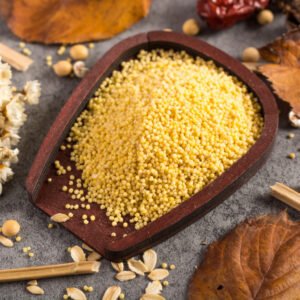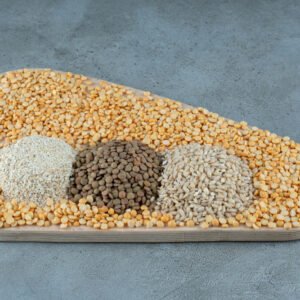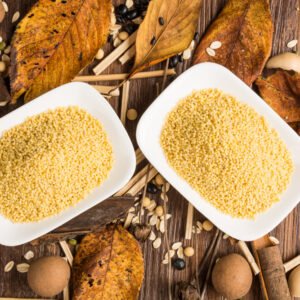The global shift toward healthier eating patterns has put ancient grains back in the spotlight. Among them, millet and quinoa have emerged as popular alternatives to traditional cereals. Both are gluten-free, packed with nutrients, and versatile in the kitchen. But which one is capturing consumer attention in 2026?
Let’s break it down.
Understanding Millet and Quinoa: What Makes Them Different?
Before comparing their market presence, it’s worth knowing what sets these grains apart.
Millet refers to a group of small-seeded grasses cultivated for thousands of years across Africa and Asia. Varieties include pearl millet, finger millet (ragi), foxtail millet, and proso millet. These grains grow in harsh climates with minimal water, making them climate-resilient crops.
Quinoa, on the other hand, is a pseudocereal native to the Andean region of South America. Though often called a grain, it’s technically a seed from the Chenopodium quinoa plant. It comes in white, red, and black varieties and has gained fame as a complete protein source.
Both millet and quinoa offer distinct nutritional profiles and culinary uses, but their popularity trajectories in 2026 tell different stories.
Also Read:- Should You Choose Green Millet or Red Millet for Weight Loss?
Millet vs Quinoa: Market Growth in 2026
Market data reveals that millet is experiencing remarkable growth. The millet market reached approximately USD 12 billion in 2025 and is projected to expand at a compound annual growth rate of 4.6% through 2030. Some analysts predict even higher growth rates, with estimates ranging from 5.3% to 13.4% depending on regional factors and product segments.
What’s driving this surge? Several factors contribute to millet’s rising popularity:
- Government support: India’s Ministry of Food Processing Industries launched a Production Linked Incentive Scheme for millet-based products with a budget exceeding USD 96 million from 2022 to 2027. The Indian government designated millets as “Nutri-Cereals,” recognizing their nutritional value.
- Production increases: According to the Indian Ministry of Agriculture, millet production grew by 12% year-over-year in 2025. This production boost has made millets more accessible and affordable.
- Health consciousness: Urban populations worldwide are seeking nutrient-dense alternatives to refined grains. Millets fit perfectly into this trend as sources of protein, fiber, vitamins, and minerals.
Quinoa maintains a strong market presence but shows different growth patterns. The quinoa market was valued at approximately USD 1.5 billion in 2024 for quinoa milk alone, with projections reaching USD 3.8 billion by 2033 at a growth rate of 12.8%. The broader quinoa market continues to expand, driven by sustained demand in North America and Europe.
Here’s why the comparison matters: millet’s growth is accelerating across multiple markets, while quinoa has reached a more mature phase with steady but slower expansion in traditional markets.
Nutritional Showdown: Millet vs Quinoa
When choosing between these grains, nutrition plays a big role. Here’s how they compare:
- Protein content: Quinoa stands out as a complete protein, containing all nine essential amino acids. This makes it particularly appealing to vegetarians and vegans. Millets contain good protein levels but are not complete proteins on their own.
- Fiber: Both grains provide substantial fiber, supporting digestive health and helping maintain steady blood sugar levels. Millets tend to have slightly higher fiber content than quinoa, depending on the variety.
- Minerals: Millets shine in mineral content, particularly iron, magnesium, and phosphorus. Finger millet (ragi) is exceptionally rich in calcium. Quinoa offers good amounts of manganese, magnesium, and folate.
- Glycemic index: Millets generally have a lower glycemic index than quinoa, making them a better choice for blood sugar management. This gives millets an edge for people with diabetes or those watching their glucose levels.
- Vitamins: Both grains provide B vitamins, though in slightly different proportions. Quinoa offers more folate, while millets contain higher amounts of niacin.
For everyday consumers, both grains deliver strong nutritional benefits. The choice often comes down to specific dietary needs and taste preferences.
Sustainability and Environmental Impact
Climate change concerns are reshaping food choices. Both millet and quinoa offer environmental benefits, but in different ways.
Millets require minimal water and thrive in marginal soils where other crops fail. They grow well in semi-arid regions without irrigation, making them ideal for areas facing water scarcity. Their short growing season and resistance to pests reduce the need for chemical inputs.
Quinoa’s environmental story is more complicated. While it grows in harsh Andean conditions, the crop’s global popularity created challenges in its native regions. Increased demand led to soil degradation in some areas and disrupted traditional farming practices. The crop also requires more water than millets, though less than wheat or rice.
From a sustainability perspective, millets offer clear advantages. Their low water requirements and adaptability to changing climate conditions position them as climate-smart crops. Organizations like CMS Industries, which supply diverse agricultural products including grains, recognize the growing demand for sustainable options.
Culinary Versatility: Cooking with Millet and Quinoa
Both grains adapt well to various cuisines, but they bring different textures and flavors to the table.
Millet characteristics:
- Mild, slightly nutty flavor
- Fluffy texture when cooked properly
- Works well in porridges, pilafs, and baked goods
- Can be ground into flour for rotis and flatbreads
- Different varieties offer distinct tastes and textures
Quinoa characteristics:
- Subtle, earthy taste with a slight bitterness
- Fluffy with a slight crunch
- Excellent for salads, bowls, and side dishes
- Cooks faster than most millets
- Maintains shape well in mixed dishes
Preparing these grains requires different approaches. Quinoa needs thorough rinsing to remove saponins, natural compounds that cause bitterness. Most millets benefit from light toasting before cooking to bring out their nutty flavor.
For families looking to incorporate either grain, start with simple preparations. Cook millet or quinoa in vegetable broth for added flavor. Mix them into salads, use them as breakfast porridge bases, or substitute them for rice in your favorite dishes.
Regional Preferences and Global Trends
Geographic factors influence which grain dominates in different markets.
- Asia-Pacific region: Millet consumption is deeply rooted in traditional diets across India, China, and other Asian countries. Government initiatives supporting millet cultivation and consumption are strengthening this trend. Urban Chinese consumers are incorporating millets into functional foods and beverages.
- North America and Europe: Quinoa maintains stronger brand recognition in these markets. It became a superfood darling over the past decade and continues to hold shelf space in health food stores and mainstream supermarkets. Millet is gaining ground but still faces awareness challenges.
- Africa: Millets are staple foods across many African nations, particularly pearl millet and finger millet. Local production meets most domestic needs, with growing exports to international markets.
- South America: Quinoa remains culturally significant in Peru, Bolivia, and Ecuador. Local consumption competes with export demand, creating interesting market dynamics.
Looking at 2026 trends, millets are expanding their footprint beyond traditional markets. CMS Industries and similar agricultural suppliers are seeing increased demand for diverse millet varieties from international buyers seeking nutritious, sustainable grain options.
Price Point and Accessibility
Cost matters for most consumers. Here’s where millet gains a clear advantage.
Quinoa typically sells at premium prices, ranging from $5 to $15 per pound depending on variety and source. Its status as an imported specialty grain in many markets keeps prices elevated.
Millets generally cost less, often selling for $2 to $6 per pound. Local production in major consuming countries keeps prices affordable. As production scales up and supply chains improve, millet prices are becoming even more competitive.
This price difference affects purchasing decisions, particularly for families incorporating these grains regularly into their diets. The affordability factor contributes to millet’s growing market penetration in price-sensitive markets.
Health Benefits That Matter
Both grains offer impressive health benefits backed by research.
Millet benefits:
- Supports heart health through magnesium and fiber
- Helps manage diabetes with low glycemic index
- Promotes bone health, especially finger millet’s high calcium
- Aids digestion through fiber content
- May reduce inflammation
Quinoa benefits:
- Provides complete protein for muscle health
- Supports weight management through satiety
- Rich in antioxidants like quercetin
- Gluten-free for celiac disease management
- Contains anti-inflammatory compounds
Medical professionals increasingly recommend both grains as part of balanced diets. Neither is inherently superior – they serve different nutritional needs.
The Verdict: Which Grain Is Trending in 2026?
Based on market data, government support, production growth, and consumer trends, millet is the clear trendsetter in 2026. Its market is expanding faster, production is scaling up, and governments are actively promoting it. The sustainability angle resonates with environmentally conscious consumers, while affordability makes it accessible to broader populations.
Quinoa remains popular and maintains steady growth, but it’s operating from a more mature market position. It’s not losing ground, it’s just not experiencing the explosive growth that millets are seeing.
The winner depends on what you value most. Choose millet for affordability, sustainability, and blood sugar management. Pick quinoa for complete protein, faster cooking, and familiar recipes.
For suppliers and distributors in the agricultural sector, the message is clear: stock up on diverse millet varieties. Consumer interest is rising, and those who can provide quality grains will capture market share. Companies like CMS Industries, based in Gujarat and known for quality grain supplies, are well-positioned to meet this growing demand for nutritious, diverse grain products.
Connect With Quality Grain Suppliers
Whether you’re a consumer seeking nutritious grains or a business looking for reliable agricultural suppliers, choosing the right source matters. CMS Industries specializes in providing high-quality grains, spices, pulses, and oilseeds to markets across the globe. With two decades of experience and a commitment to quality, they support the growing demand for healthy, sustainable food products.
Interested in learning more about grain options or sourcing quality millets and other agricultural products? Visit the CMS Industries website to explore their range of offerings and connect with their team.
Frequently Asked Questions
Q.Is millet healthier than quinoa?
Both grains offer distinct health benefits. Millet has a lower glycemic index and higher fiber content, making it better for blood sugar control. Quinoa provides complete protein with all essential amino acids. Your choice should depend on your specific nutritional needs: diabetics might prefer millet, while vegans seeking protein might choose quinoa.
Q.Why is millet gaining popularity over quinoa in 2026?
Millet’s rise stems from several factors: government support programs, particularly in India; lower production costs making it more affordable; better sustainability credentials with minimal water needs; and growing awareness of its nutritional benefits. Market data shows millet production grew 12% in 2025, while accessibility has improved globally.
Q.Can I substitute millet for quinoa in recipes?
Yes, but expect texture and taste differences. Millet has a nuttier flavor and softer texture compared to quinoa’s slight crunch. Cooking times differ too – quinoa cooks in about 15 minutes while most millets need 20-30 minutes. Start by substituting in forgiving dishes like grain bowls and salads before trying baked goods.
Q.Which grain is better for weight management?
Both support weight loss through high fiber and protein content that promote fullness. Millet’s lower glycemic index helps prevent blood sugar spikes and crashes that trigger hunger. Quinoa’s complete protein supports muscle maintenance during calorie restriction. Either works well in a balanced weight management plan.
Q.Are millets and quinoa truly gluten-free?
Yes, both are naturally gluten-free, making them safe for people with celiac disease or gluten sensitivity. But always check product labels cross-contamination can occur during processing if facilities also handle wheat products. Buy certified gluten-free versions if you have severe gluten intolerance.




